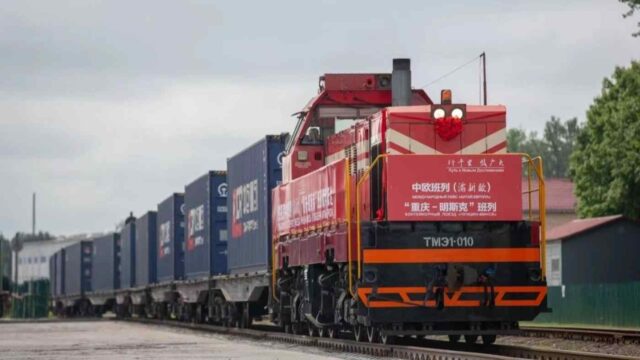
As Putin’s War Disrupts Eurasian Railways, China Investigates Alternatives
Publication: Eurasia Daily Monitor Volume: 19 Issue: 158
By:

Russian President Vladimir Putin’s “special military operation” against Ukraine has severely impacted Eurasian transport logistics, particularly cargo traveling along the People’s Republic of China’s (PRC) Belt and Road Initiative (BRI) bound for Europe via Russian Railways (RZD). In 2021, China Railway Express (CRE), a subsidiary of China Railways Group, dispatched 15,000 trains to and from Europe, carrying 1.46 million 20-foot equivalent units (TEUs)—a year-on-year increase from 2020 of 22 percent and 29 percent, respectively (China Railways, March 10).
For the CRE trains, routes connecting the PRC and Russia accounted for the largest share of trade volume—at nearly 7,000 trips, with approximately 80 percent of their cargo consisting of high-value, low-volume items such as personal computers, electronics, machinery and auto parts (Nikkei Asian Review, March 28). The PRC’s BRI rail traffic dispatched on the RZD via Russia has plummeted since Moscow began its re-invasion of Ukraine on February 24. Combined with increasingly harsh sanctions, this has compelled the PRC’s exporters to search for alternatives.
A month after Russian aggression began, European Rail Freight Association Secretary General Conor Feighan noted that, due to the invasion, “the notion of a globalized supply chain is being torn asunder,” adding that with RZD being the main operator on the route and the only carrier willing to cross the Russian border, “the northern Silk Road has been significantly hampered” (International Railway Journal, March 25). Railway traffic disruptions have been particularly significant in Kazakhstan—a key BRI country.
In 2021, Kazakhstan served as a BRI stop that was crossed by a record number of transit containers—one million TEUs. In April 2022, five weeks after the Russian offensive began, this volume fell by 21 percent. Even worse was the decrease in Europe-PRC train shipments, whose numbers immediately shrank by 43 percent (Vlast.kz, September 21).
Amid economic sanctions imposed after the military operation, the Kremlin increased its search for additional revenue by sharply raising transit fees, impacting Eurasian road, air and rail cargo flows via Russia. Exporters stated that, before military operations began, logistics costs in Russia were 5 to 30 percent of export costs, which subsequently rose to between 50 and 60 percent. These soaring costs have impelled transport companies to search for less costly Eurasian rail alternatives to Russia’s RZD trains (Kommersant, September 1).
Statistics have driven the search; in the decade since it was first announced, the PRC’s BRI has grown exponentially. Via 82 Eurasian routes, Chinese trains laden with merchandise now service 200 European cities in 24 countries, utilizing an upgraded European-wide railway network (Xinhua, September 10).
The emerging primary RZD interim alternative is the Trans-Caspian International Transport Route (TITR), also known as the Middle Corridor. The TITR begins in China and transits to Kazakhstan to its Aktau Port on the Caspian Sea, where trains are loaded onto roll-on/roll-off ferries for the voyage to Baku. TITR trains are dispatched westward through Georgia and on to Europe via the Baku-Tbilisi-Kars railway or via Black Sea ferries to Bulgaria and Romania. The TITR logistics corridor is an extension of the Europe-Caucasus-Asia Transport Corridor, involving the European Union and 12 states from Eastern Europe, the Caucasus and Central Asia. The TITR originated in 2016 when Azerbaijani, Kazakhstani and Georgian railway and port authorities signed an agreement to develop the route.
The TITR’s potential aligns with the efforts of post-Soviet Central Asian and South Caucasian nations to strengthen their independence and further their economic prosperity through locating foreign direct investment for their substantial infrastructure needs, estimated by the Asian Development Bank at $33 billion annually through 2030 (Asian Development Bank Institute, October 2021). Less than two months after hostilities began, the TITR International Association projected that, by the end of 2022, TITR traffic volumes could surge six-fold to 3.2 million tons (Ferghana.ru, May 11).
Further underlining Beijing’s ambitions in the region, in September 2022, China, Kyrgyzstan and Uzbekistan signed a landmark deal on building a railway that will provide a shorter route to Europe, bypassing Russia in the process. The project will be jointly funded and constructed by the three states, with Beijing responsible for building 160 kilometers of the new line. According to reports, the railway will shorten the route from China to Europe by almost 1,500 kilometers and decrease travel time by eight days (Eurasianet, September 15). In truth, China is open to developing numerous multilateral economic relationships to achieve its interests. Overall, Beijing has tried to adopt an apolitical approach to the BRI, even as the PRC is now the top trading partner of more than 100 countries (OborEurope.com, August 5, 2021).
While TITR’s transit volumes are currently a fraction of the rail cargo the PRC used to send to Europe via RZD, the Middle Corridor represents a viable logistical alternative as long as Russia’s current geopolitical outlook remains murky, as Beijing’s interest in sustaining its access to lucrative European markets remains. Likewise, as long as Putin’s assault on Ukraine continues, the PRC’s interest in developing alternative Eurasian railway routes that safeguard its access to European markets will only increase.



